How long can whales hold their breath underwater? On average, whales can hold their breath for up to an hour underwater. Yet, sometimes, they can remain submerged much longer than expected. The longest whale breath-holding record was a stunning 222 minutes!
Curious to know more about how they hold their breathing for a long time? Well, this article will let you know everything about that.
How Long Can Whales Hold Their Breath?
How long can a whale hold its breath? Generally, a whale can stay underwater for up to an hour before breathing. However, the time a whale can hold its breath depends on factors like its species, where it lives, and how much food is around.
Research shows that the Cuvier’s beaked whale set a record. It stayed underwater for 222 minutes, the longest dive by any mammal! Other whale species, like sperm whales, can also stay underwater for a long time.
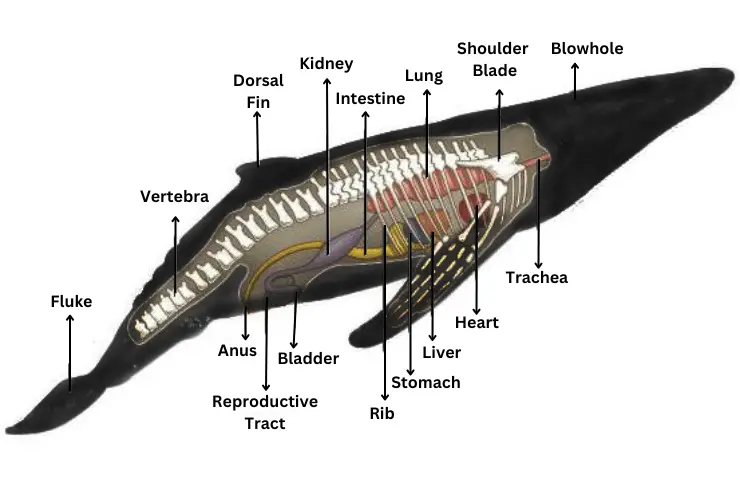
Back in 1969, a whale dived for 117 minutes. Sadly, it was killed near the coast of South Africa when it came up for air. Plus, sperm whales can hunt underwater for about 90 minutes before needing air.
When sleeping, whales usually hold their breath for 40 to 60 minutes. Thanks to modern tech, we can watch these amazing animals deep in the ocean like never before. This lets us learn how long they can stay underwater and admire their beauty.
Different Whale Species and Their Breath Holding Time
Want to know which whales hold their breath for how long? Have a look at the table below.
| Whale’s Species | Breath holding time |
| Blue Whale | 90 minutes |
| Sperm Whale | 90-120 minutes |
| Fin Whale | 10-20 minutes |
| Humpback Whale | 5-10 minutes |
| Gray Whale | 30 minutes |
| Sei Whale | 20 minutes |
| Beluga Whale | 15 minutes |
| Bowhead Whale | 40 minutes |
| Minke Whale | 20 minutes |
| Narwhal | 25 minutes |
| Pilot Whale | 10 minutes |
| Beaked Whale | Over 180 minutes |
| Bryde’s Whale | 5-15 minutes |
How Can Whales Hold Their Breath for So Long?
Whales can hold their breath for long periods due to their unique body features that help them use less oxygen. Whales have a special way to store oxygen in their blood and muscles. Instead of using their lungs, they rely on proteins like hemoglobin and myoglobin.
While diving, whales slow down their heart rate. This helps them use the remaining oxygen in their body more wisely. They focus the blood flow on important organs like the liver and kidneys. It’s a smart move for deep diving.
Many whale species have a shape that makes it easy to glide through water. For instance, beaked whales have spots where their flippers fit just right. This shape helps them use less energy and oxygen.
All these tricks help whales, like sperm whales and orcas, to stay underwater longer. They can dive deep without looking tired or stressed. These traits make them experts in deep-sea diving, which is truly amazing to think about!
What Environmental Factors Enable Whales to Stay Underwater for a Long Time?
Both the body features and the environment help whales stay underwater for a long time. In cold water, whales can hold their breath longer. This lets them save more energy and oxygen.
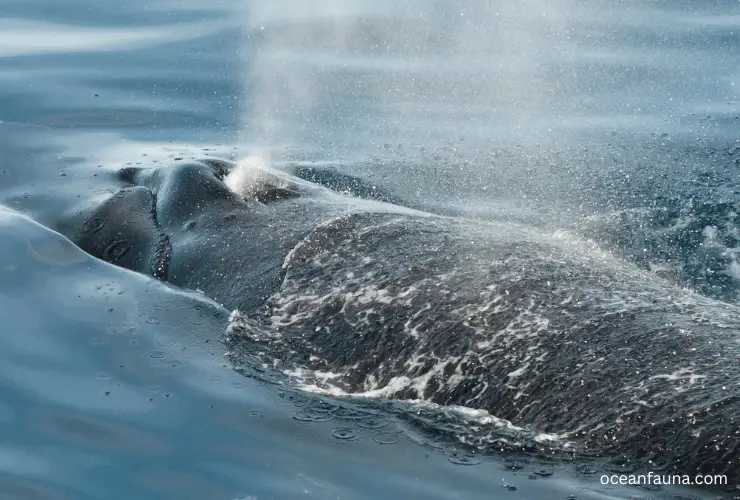
If a whale lives where food is easy to find near the surface, it doesn’t have to dive deep. This lets it stay underwater longer. It also avoids risks, as sharks usually stay in deeper waters.
Whales make smart use of underwater currents to save energy while they dive. This is another way they use their habitat to their advantage.
C whales can dive long without getting too tired or running low on oxygen by making the most of their water homes. So, it’s not just their body smarts; their surroundings play a big part, too. This allows them to explore deep waters and find food without any fuss.
How Deep Can a Whale Dive in One Breath?
How deep can a whale dive in just one breath? It’s a question that boggles the mind. Cuvier’s beaked and sperm whales are famous for diving deep. Still, how deep they go can differ from one whale to another.
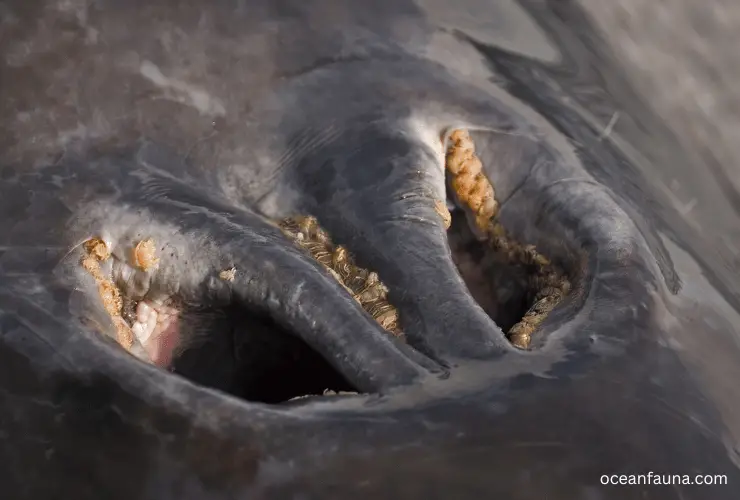
Most whales can dive between 100-500 meters and stay under for 60-90 minutes. But hold on, sperm whales are an exception. They’ve been seen diving over 1200 meters!
How long and how deep a whale can dive in one breath depends on its metabolism and oxygen storage. Simply put, different species have different limits.
A whale’s age matters too. Younger whales often dive for shorter times because they use up oxygen faster. So, youth isn’t always a perk in the deep-sea diving game.
Water temp is another biggie. In cold water, a whale’s body slows down, letting it save more oxygen. This means they can stay underwater longer in cold spots like Alaska. Some baleen whales, for instance, can stay under for 40 minutes in waters colder than 4 degrees Celsius. So, next time you’re chilling in Alaska, think about the whales beneath you!
How Do Whales Breathe?
Like other sea mammals, whales get their oxygen from the air. They breathe much like land mammals do. When a whale needs to breathe, it pops up to the surface. It sucks in the air through its blowhole and then lets it out.
So how do whales breathe? They have two key parts: their lungs and a blowhole. The blowhole sits right on top of their head. It works like a nose, letting air go in and out of the lungs. A piece of skin, known as the baleen flap, covers the hole.
This baleen flap lifts when a whale takes a breath. Take the blue whale as an example. One breath can pull in a whopping 5,000 liters of air!
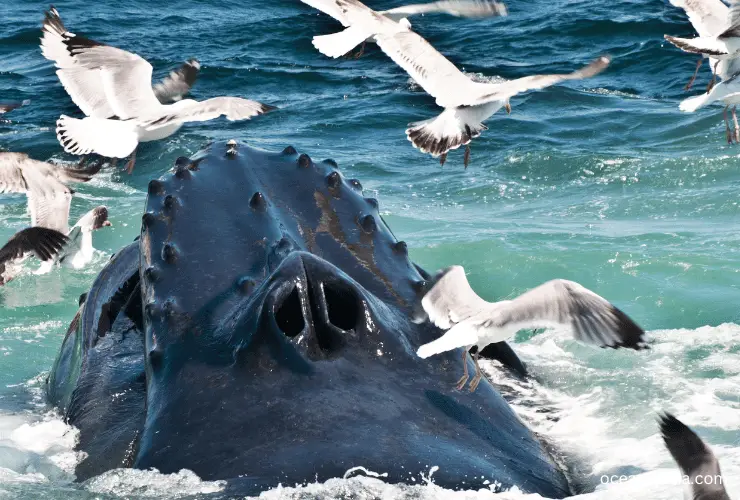
After breathing in through its blowhole, the whale sends the air to its lungs. There, the whale swaps gases. Oxygen then flows into the whale’s bloodstream. This helps its cells grow, repair, and burn energy.
As the whale breathes out, it gets rid of carbon dioxide. This waste gas enters little air sacs in its lungs and exits through the blowhole.
Whales have a special organ called the dorsal diverticulum. This stores oxygen-rich blood for when they need to breathe again. This organ helps them have enough oxygen while diving deep.
The dorsal diverticulum also keeps whales buoyant by storing nitrogen-rich fluid from their breaths. This helps deep-diving whales like sperm, and beaked whales control how floaty they are.
How Much Oxygen Can a Whale Hold?
Whales are amazing at storing oxygen. They can take in up to 90% of the oxygen in one breath. That’s way more than humans can do!
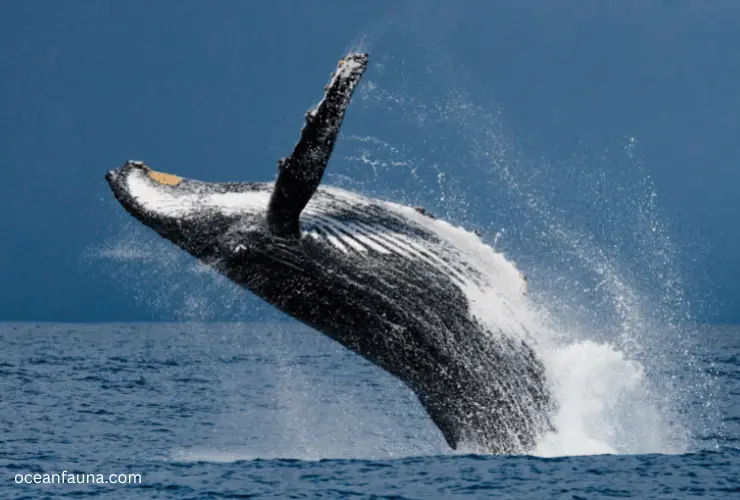
Experts think whales have evolved to hold their breath for so long because they dive deep. They often can’t get fresh air while underwater.
A whale’s body is built for this. Its jaws and nose are different from ours. These help the whale take in more air when it breathes.
Before a dive, a whale breathes out to sink more easily. Then, it holds its breath while underwater. When underwater, whales trap air in their special lung tissue. This air has up to 30 times more oxygen than seawater. It lets them stay down longer.
To make their oxygen last, whales have some cool tricks. Whales have special muscles between their ribs. These muscles ease lung stress when they dive deep. They help us use oxygen better.
Whales also swim in slow, easy moves. This saves energy and lets them stay underwater longer in one breath. So, when it comes to holding oxygen, whales are the true champs of the sea!
How Much CO2 Does a Whale Absorb?
Whales do a great job of helping our oceans and the planet. They’re big players in balancing CO2 levels. Because they live long and die in a unique way, they soak up a lot of CO2.
An average whale can hold up to 33 tons of CO2 in its lifetime. That’s way more than a regular tree, which takes in just 48 pounds of CO2 each year.
When whales die, they sink deep in the ocean. The CO2 in their bodies stays there for centuries, helping to lock it away from the air.
But there’s a catch. If whales die deep down, they don’t get enough oxygen for their bodies to break down fully. So, even if whales take a lot of CO2 out of the air when they die, it’s not locked away forever right away.
FAQs
What mammal can hold their breath the longest?
The mammal that can hold their breath the longest is the Cuvier’s beaked whale, which has been recorded diving for 222 minutes in one breath. However, other whales, such as sperm whales and beluga whales, can also hold their breath for extended periods of time. It ultimately depends on different factors such as species, age, and water temperature.
Do whales have gills?
No, whales do not have gills like fish. Instead, they have lungs like other mammals. They breathe air through the blowhole on top of their head.
Do all whales have the same lung capacity?
No, different species of whales have different lung capacities and, therefore, can hold varying amounts of oxygen in one breath. Factors such as metabolism and age also play a role in the capacity of whales’ lungs. Overall, blue whales have the largest lung capacity among whales.
Conclusion
We hope this article answers your questions about how long whales can stay underwater. In fact, whales can stay underwater longer than any other mammal—sometimes over an hour.
So, there you have it. Whales are truly unique when it comes to holding their breath and exploring the ocean’s depths.

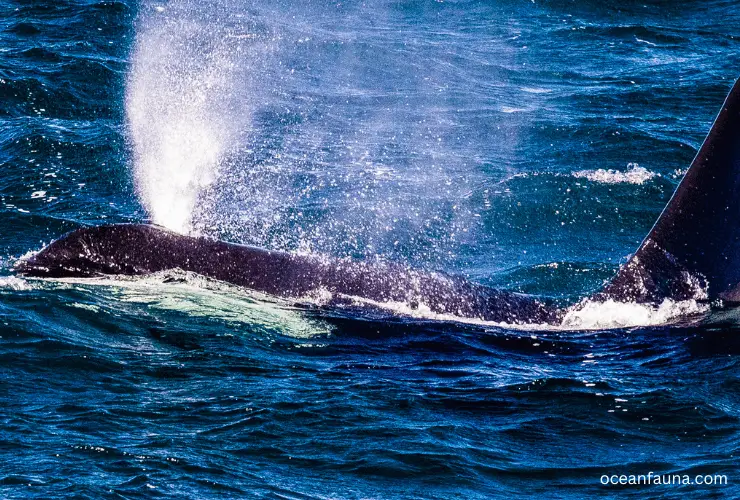
2 thoughts on “How Long Can Whales Hold Their Breath Underwater?”